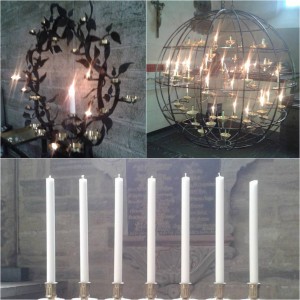At the first service I attended in the Church of Sweden, my eyes were captured by the numerous Candles (Ljus) lit inside the house of worship.
Back in my church, it was enough to light at least two candles during the Mass but here, candles can be seen around the altar and for some, spread throughout the church’s interior.
Based on several interviews made, I found the main reason behind this candle trend in the Church of Sweden. That is to make the people feel at home when they are inside the building to attend worship. This could be traced back to the olden times of Sweden when the homes were cold and dark especially during winter and people used candles to provide warmth and light inside their own abodes.
Mainly, candles are part and parcel of the Swedish life. In fact, the practice of lighting candles inside the home, restaurants, offices and churches is still evident up to the present time.
Aside from serving as the liturgical symbol of God’s presence, the Church has adopted such practice in a more meaningful way and that would lead to another unique feature of the Church of Sweden’s liturgy. It is when they offer prayers as they light candles during the Mass or in a service.
The next gesture which caught my attention was the clock ringing and the extreme Tystnad (Silence) that calls everyone into deep prayer before the service begins. Inside the Swedish liturgical service, there is also a point wherein complete silence is required as everyone is asked to pray for their individual intentions.
Apart from those, what I consider as the best feature of Svenska Kyrkan (Church of Sweden) is the shortened form of Mass. A sung Mass with at least four songs from the Psalmboken (Hymn Book) would run for a maximum time of an hour but the recited Mass would consume only half an hour.
Once more, the Church of Sweden can be seen in this example as a church answering the needs of the people. Long services could be as meaningful and lively as the shortened one. Even in schools, it is not advisable to conduct long lectures as it will not cause good effects on its students.
Looking back to Jesus’ days on earth, He adjusted to the needs of the people, went to places where people gathered; walked the streets and visited houses in order to preach the Gospel so that all may hear. That is what I also think churches should do, to answer the needs of the people.
This liturgical renewal of the Church of Sweden is worth replicating for many churches all over the world who are still conducting long Mass celebrations lasting up to two hours and more. Years from now, there could be a big possibility for people in other countries to be bored, lose concentration or may drop the choice of going to Mass on Sundays due to the length of the service.
Another observation about the Mass is the varied forms used in each church. This is due to the ongoing study and observation on the implementation of the new Mass form and new church handbook. Some parishes use a certain form with several prayers but some are a bit musically accented.
One may notice that in most parishes, music plays an important role in encouraging people to join in the corporate worship.
Over the weeks of attendance in the church services, the liturgical celebrations have been simple, less complicated yet meaningful. Apart from the hymns, the preludes and postludes speak of the celebration’s theme played by equally-talented musicians.
But of all the gestures, there is this one thing that personally struck me in all the Masses I have attended in the Church of Sweden. It is when the priest partakes of the communion after everyone has been given the bread and wine. This may sound simple for many but as I view it, the gesture symbolizes how the clergy should act – to be humble in serving the people. (In my church, the priest is first to partake of communion symbols before distributing to the congregation.)
Lastly, Svenska Kyrkan, pursuing the mission as a worldwide church, has the unique feature of having an open table to anyone, regardless of church denomination, who may want to partake of Christ’s meal during the Mass.
On the other hand, Church of Sweden’s liturgical life is a mix of everything beautiful from the Catholic and Protestant traditions. Described as the “bridge church,” it has remained faithful over the years to the Mass form similar to the Roman Catholic Church (with slight revisions) but also holds fast to Protestantism’s flavor of giving more emphasis to preaching within the service – the mark of what is called the Evangelical Lutheran identity.
//Klein F. Emperado is one of the exchange students in the exchange programme ”Young in the World Wide Chuch” 2014. During three months he will be spending time in Sweden, sharing life, faith and every day life. Klein is a Mass Communications graduate from Silliman University, Dumaguete, Philippines and also he works as Editorial Assistant for the said university. In the exchange he represents the Philippine Independent Church/Iglesia Filipina Independiente. His line of ministry is focused mainly on Liturgy and Music for the Diocese of Negros Oriental and Siquijor.
// Klein F. Emperado är en av deltagarna i utbytesprogrammet Ung i den världsvida kyrkan 2014. Under tre månader delar han vardag, tro och liv med människor här i Sverige. Under sin första månad spenderar han tid i St Mikaels församling i Stockholms stift. Klein har tagit examen i masskommunikation vid Silliman University, Dumaguete, Filippinerna och han jobbar idag som redaktörsassistent för nämnda universitet. I utbytesprogrammet representerar han den Filippinska oberoende kyrkan (Iglesia Filipina Independiente). Hans stora intresse och inriktning innom kyrkan är främst liturgi och musik för stiftet i Negros Oriental och Siquijor.

Lämna ett svar